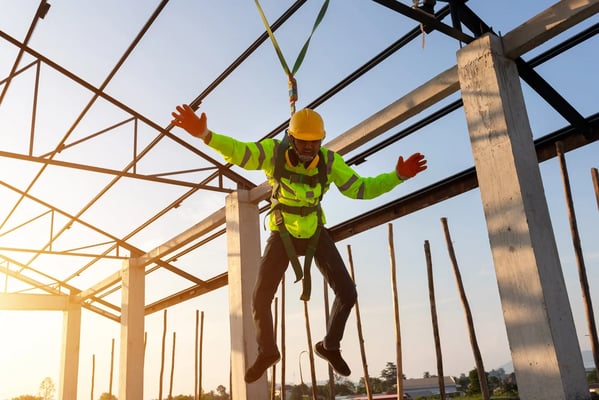
What Is Maximum Arresting Force?
There is a common misconception amongst untrained workers (and sometimes even trained ones) that donning personal fall arrest equipment removes all chance of harm or injury to the worker. Fall arrest equipment indeed will prevent contact with a lower level when a fall occurs. However, a fall victim will inevitably feel some fall forces during fall arrest. Fall protection equipment is pretty wonderful, but it is not magic. The rapid decrease in speed from a free fall to an arrested stop can be more than just uncomfortable, it can be downright dangerous if not properly controlled with the right equipment. The forces exerted on the user when a fall occurs is referred to as the arresting force.
This might seem straightforward, but maximum arresting force (or MAF) is the peak of the anticipated fall forces a worker will experience during a successfully arrested fall.
OSHA 1926.502(d)(16)(ii) states that fall protection systems must limit maximum arresting forces to 1800 lbs. In other words, anyone properly wearing a full-body harness and properly connected into their personal fall arrest system cannot be subject to more than 1800 lbs of force when a fall occurs. Shock-absorbing connecting devices can further decrease the amount of force the user will experience. The distance the worker falls before their connecting device begins decelerating their fall (free fall), the distance traveled during a fall while shock-absorbing is occurring (deceleration distance), and the shock-absorbing qualities of the connection device will ultimately determine the MAF a user will experience during fall arrest.
Since every fall is different & unique, this amount will vary, so it’s vital to consult each product’s label and/or user manual.
For example, most standard 6ft shock-absorbing lanyards will have 900lb MAF printed on the shock pack label. They accomplish this by having a fairly long deceleration distance (approximately 42in) and a beefy shock pack. In contrast, a typical 6ft SRL-P (Personal Self Retracting Lifeline) will have a shorter deceleration distance (approximately 24in), but users can be exposed to up to 1,350 lbs. MAF. Typically, shorter deceleration distances will equate to increased fall forces.
Ideally, we want to minimize MAF whenever possible. We can accomplish that by elevating anchor points, using SRLs over lanyards to eliminate free fall, and using equipment with longer deceleration distances.
This is all great info, but why is maximum arresting force important? Well, OSHA 1926.502(d) states anchorages must be “capable of supporting at least 5,000 pounds” or “have sufficient strength to withstand twice the potential impact energy.” When using non-certified (AKA off-the-shelf) anchors, the supporting structure must withstand 5,000 lbs. of force. However, there are circumstances when the supporting structure where anchorage is required cannot withstand a 5,000 lb. load and a qualified person must certify an anchorage. The MAF anticipated by the connecting device in the personal fall arrest system will determine the force the certified anchor must withstand.
When the Diversified Fall Protection team needs to create a custom, engineered fall protection system, the maximum arresting force will determine how strong the anchorage support structure must be to support the system. Our goal is to design systems with as little MAF as possible and decrease the amount of fall forces users will experience if they succumb to a fall. When we minimize MAF, we also minimize the risk of injury during fall arrest.
Whether you need assistance assessing your facility for fall hazards, training personnel on their fall protection hazard awareness, or installing turnkey fall protection solutions, the first step is getting in contact with your local fall protection specialist. If you’re ready to take the next step in further protecting your workers from falls, get in touch with us and someone from our team will be in touch with you shortly!
Schedule an assessment with Diversified Fall Protection
Contact Us to request a fall safety review

b-1.jpg?width=1368&height=1340&name=Rail%20(175)b-1.jpg)

